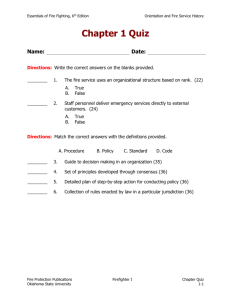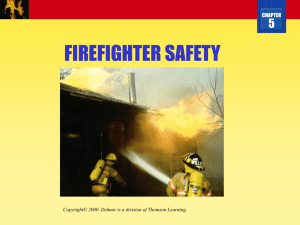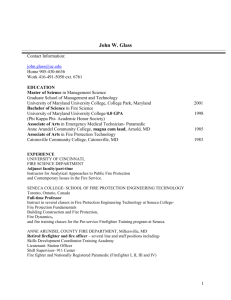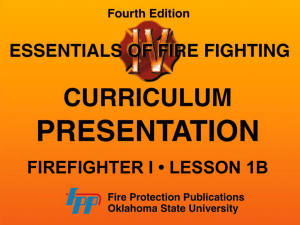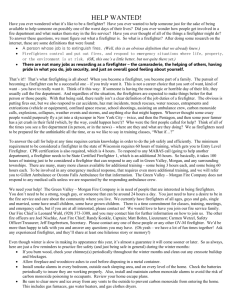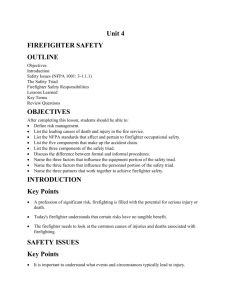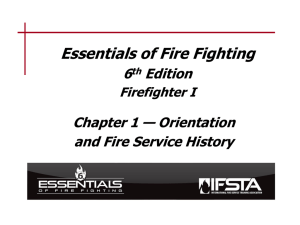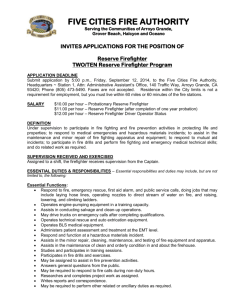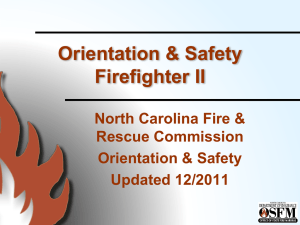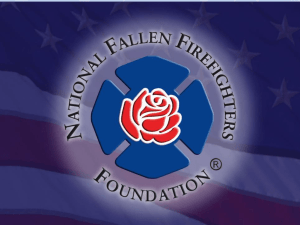Implementing the 16 Firefighter Life Safety Initiatives
advertisement
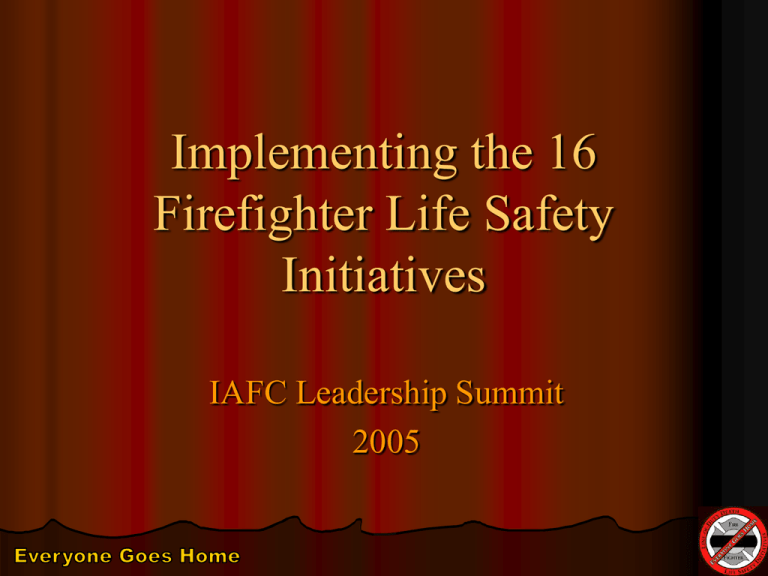
Implementing the 16 Firefighter Life Safety Initiatives IAFC Leadership Summit 2005 This is a discussion forum for Fire Service Leaders Your participation is requested… Please share your thoughts and ideas. Everyone is in favor of Firefighter Safety Everyone is in favor of Firefighter Safety Everyone supports the 16 initiatives (at least in principle) Everyone is in favor of Firefighter Safety Everyone supports the 16 initiatives (at least in principle) Everyone agrees they are important Everyone is in favor of Firefighter Safety Everyone supports the 16 initiatives (at least in principle) Everyone agrees they are important How do we implement them? The Fire Service Senior Executive’s Implementation Guide for the 16 Firefighter Life Safety Initiatives The Fire Service Senior Executive’s Implementation Guide for the 16 Firefighter Life Safety Initiatives Not to be confused with Safety for Dummies 1. Culture Establish an organizational culture that fully embraces health and safety 1. Culture Establish an organizational culture that fully embraces health and safety Organizational values and beliefs Accountability at every level Risk-based incident management Stop unsafe practices 2. Individual Capabilities Ensure that every member is capable of performing all expected duties: 2. Individual Capabilities Ensure that every member is capable of performing all expected duties: Training KSAs Professional qualifications Certifications (re-certifications) Performance evaluations Medical examinations Physical fitness evaluations 3. The Right Stuff Ensure that your fire department has and uses appropriate tools, equipment and procedures: 3. The Right Stuff Ensure that your fire department has and uses appropriate tools, equipment and procedures: Meets appropriate standards Current technology Properly inspected and maintained Used as intended (Prioritize Grant Funds) 4. Drive Safely Arrive alive (and don’t kill anyone else on the way) 4. Drive Safely Arrive alive (and don’t kill anyone else on the way) Adopt safe driving rules and procedures Enforce them Driver training Emergency vehicle driver’s license Seat belts! Secure loose objects in cabs and on vehicles Reduce unnecessary emergency responses Practice scene safety 5. Investigate and Evaluate Understand why things go wrong and don’t let it happen again 5. Investigate and Evaluate Understand why things go wrong and don’t let it happen again Investigate all accidents and injuries Near-miss reporting Analyze data and trends Learn the lessons and implement the findings Continual self-evaluation 6. Prevention Reduce Incidents Reduce Risks 6. Prevention Reduce Incidents Reduce Risks Public Education Code adoption and enforcement Residential sprinklers 7. The Rest of the List Counseling and psychological support Violent incident protocol Research and data analysis History Lesson NFPA 1500 – adopted in 1987 History Lesson NFPA 1500 – adopted in 1987 “too radical for the times” Needed time to phase-in History Lesson NFPA 1500 – adopted in 1987 “too radical for the times” Needed time to phase-in Added language “set a date or dates for achieving compliance” “establish a phase-in schedule” History Lesson NFPA 1500 – adopted in 1987 “too radical for the times” Needed time to phase-in Added language “set a date or dates for achieving compliance” “establish a phase-in schedule” Is 18 years long enough? Today’s Revelation If we fully comply with NFPA 1500, we have successfully implemented most of the 16 initiatives. Start 1500 by evaluating compliance with NFPA Check list is in the standard Self-Evaluation Organizational Culture Have we made firefighter safety and health a primary value of the organization? Does every member understand the organizational emphasis on health and safety? Does every manager and supervisor understand their personal responsibility to implement safety policies and procedures? Are we holding people accountable for compliance with health and safety policies? Leadership Has the Fire Chief accepted the responsibility for health and safety policies and programs Does the Fire Chief “walk the walk” and “talk the talk”? Does the Fire Chief know if the health and safety policies are being followed? Is there a gap between what we think is going on and what is really going on? Human Resources Does every firefighter have the training (knowledge, skills and abilities) to perform all expected duties? Is every firefighter physically fit? Physical fitness program Fitness evaluations Performance standards Is every firefighter healthy? Regular medical examinations by qualified physician Standard Operating Procedures Do we have them? Do we follow them? Do we really follow them? Are we using the procedures or just using the terminology? Risk Management Does everyone understand the difference between and acceptable risk and an unacceptable risk? Do you have a system to pre-identify unacceptable risks? Incident Management Can we really account for the position, function and status of every firefighter on the incident scene? Is every firefighter connected to the plan for the incident? Does the Incident Commander know what is really going on? Equipment Do Is it properly maintained and inspected? Do Is we have all of the “proper” equipment? you have records? it used according to the design parameters? Vehicles Does every vehicle meet current design standards for safety? Has every vehicle been inspected … and passed? Do we have criteria for taking vehicles out of service? Do we ensure that all new vehicles incorporate every safety feature? Seat Belts Is Is everyone really seated and belted? everything else in the cab properly secured? Response Policies Do we really stop at red lights and stop signs? Do we really drive according to the rules? Do we have policies to limit emergency response to true emergency incidents? What if we didn’t use red lights and sirens? Investigations When something goes wrong, how thoroughly do we investigate? Near miss Minor accident or injury Major accident or injury Fatality Are we prepared to tell the truth about what happened? Do we implement the findings of the investigation? Does anyone pay attention to the little stuff? Coming Soon The IAFC Guide to Self-Analysis of Health and Safety Programs and Vulnerability Assessment Safety, Health and Survival Section Metropolitan Chiefs Section US Fire Administration National Fallen Firefighters Foundation National Fallen Firefighters Foundation It is up to all of us to make sure Everyone Goes Home THE END U.S. Fire Administration
